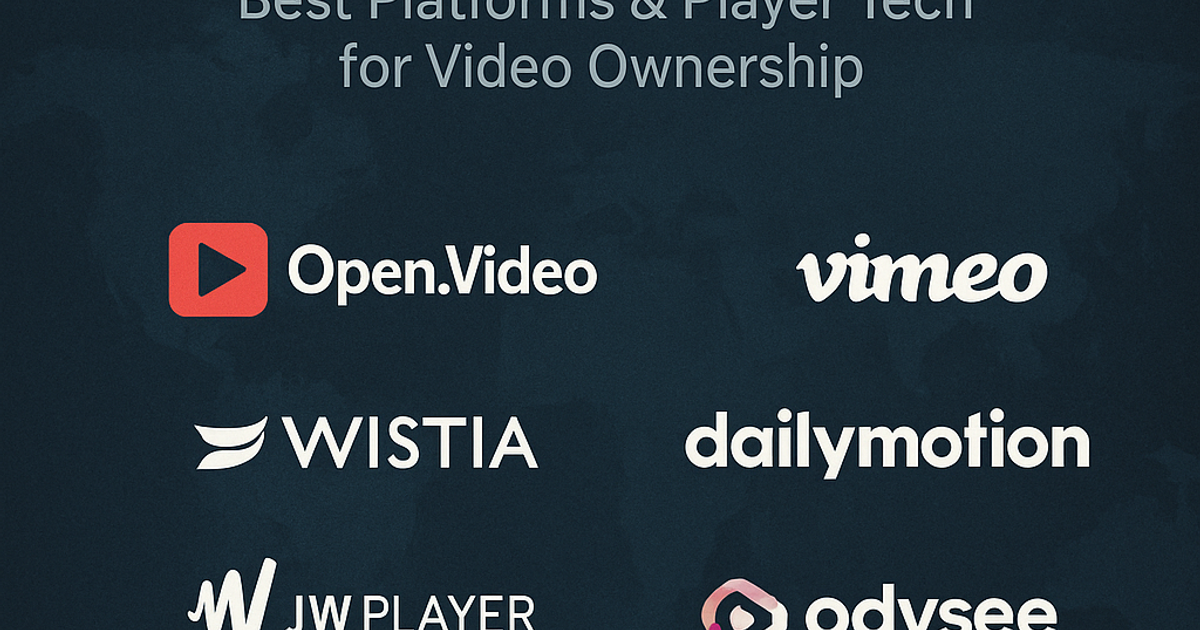The Top 12 YouTube Alternatives for 2026
YouTube isn’t the only game in town. This 2026 guide breaks down twelve top alternatives including: Vimeo, Wistia, Open.Video, Rumble, and more - helping creators and brands find the right balance between reach, control, and monetization.

The Top 12 YouTube Alternatives for 2026
A Buyer’s Guide for Serious Creators and Brands
Why This Guide
YouTube remains the dominant player in online video, but it’s not the only one. For creators, educators, and brands looking for more control, flexibility, or unique audience reach, several strong alternatives now exist.
Whether your goal is better branding, monetization, data ownership, or distribution, this guide explores twelve of the best YouTube alternatives in 2026: from enterprise-grade hosting to open-web innovation.
How to Choose the Right Alternative
Before comparing, filter each option through a few key lenses:
1. Open.Video - The Open Web’s Video Engine
Open.Video is not a typical platform, it's a full ownership ecosystem for creators and publishers. Instead of building on a big tech platform, you host video directly on your own domain with SEO-optimized watch pages.
Key Features
Pros: Total ownership, SEO-ready pages, flexible monetization Cons: Requires your own domain and setup strategy Best for: Creators, educators, and publishers ready to control their traffic and revenue
2. Vimeo - Polished and Professional
Vimeo remains one of the most recognizable alternatives to YouTube, offering high-quality playback, customizable players, and an ad-free viewing experience.
Key Features
Pros: Ad-free environment, great for filmmakers and brands Cons: Bandwidth costs scale quickly; limited SEO reach Best for: Creative professionals, agencies, and marketing teams
3. Wistia - Built for Marketing and Lead Generation
Wistia positions itself as a video platform for marketers, focusing on analytics, conversion tools, and integrations rather than audience discovery.
Key Features
Pros: Strong marketing insights; business-friendly integrations Cons: Limited monetization models; pricing rises with usage Best for: SaaS, B2B, and demand-generation marketers
4. Dailymotion - A Familiar, Global Alternative
Dailymotion offers a layout and discovery experience similar to YouTube, with a stronger presence in Europe and Asia.
Key Features
Pros: Global reach; less saturated than YouTube Cons: Smaller U.S. audience; limited data ownership Best for: Independent creators seeking exposure beyond YouTube
5. Rumble - Creator-First and Ad-Driven
Rumble has gained traction among independent creators for its straightforward monetization and emphasis on free expression.
Key Features
Pros: Transparent revenue sharing; fast-growing creator base Cons: Limited brand customization; algorithm-heavy content feed Best for: Creators looking for monetization without platform censorship
6. Vevo - The Home of Official Music Video Content
Vevo is best known for hosting premium music videos and working with artists, labels, and streaming partners. While not a traditional creator platform, it represents an important distribution option for the entertainment industry.
Key Features
Pros: Huge reach; professional infrastructure Cons: Restricted to verified artists and rights holders Best for: Music labels, artists, and entertainment brands
7. Brightcove - Enterprise-Grade Video Infrastructure
Brightcove delivers a full suite of hosting, analytics, and monetization tools for large publishers and OTT platforms.
Key Features
Pros: Scalable, secure, professional Cons: Expensive; requires technical setup Best for: Media companies, OTT services, and large enterprises
8. JW Player - Lightweight and Developer-Friendly
Originally a simple video player, JW Player has evolved into a powerful hosting and ad-monetization platform.
Key Features
Pros: Fast, flexible, and scalable Cons: Enterprise pricing for advanced features Best for: Publishers, broadcasters, and technical teams
9. Odysee - The Decentralized Option
Odysee, powered by the LBRY blockchain, provides creators a censorship-resistant, community-driven publishing platform.
Key Features
Pros: Independent, censorship-resistant, community-driven Cons: Niche audience; fluctuating crypto payouts Best for: Web3 creators and independent voices
10. SproutVideo - Small Business and eLearning Friendly
SproutVideo offers white-label video hosting tailored to small businesses, educators, and internal communications.
Key Features
Pros: Affordable and easy to brand Cons: Limited content discovery or syndication Best for: Educators, trainers, and SMB content publishers
11. PeerTube - The Open-Source Challenger
PeerTube uses federated hosting, letting anyone create their own instance and connect to others via ActivityPub.
Key Features
Pros: Total independence and customization Cons: Requires technical skill; limited visibility outside the fediverse Best for: Developers, nonprofits, and open-web advocates
12. Video.js - The Developer’s Video Foundation
Video.js is an open-source player framework used by countless media companies to build custom streaming experiences.
Key Features
Pros: Free, open, endlessly customizable Cons: No hosting or built-in monetization Best for: Developers and engineering teams building custom video platforms
Final Takeaway
YouTube continues to dominate in reach and visibility, but it’s no longer the only path.The best alternative depends on your goals: whether that’s ownership, branding, control, or audience expansion.
Platforms like Vimeo and Wistia excel in presentation and marketing. Brightcove and JW Player lead in enterprise flexibility. And Open.Video stands out as the bridge between platform convenience and full ownership - empowering creators to host, monetize, and grow entirely on their own domain.
Build Your Own Video Presence with Open.Video
If your next step is to build a video strategy you fully own, Open.Video gives you the foundation to do it:
Start your owned-video journey today at Open.Video.
About Jeff Bernard
Jeff Bernard brings a wealth of experience in curating innovative digital strategies that drive user acquisition, engagement, and ultimately, digital revenue growth. He currently serves as VP of Content Partnerships at Open.Video, where he helps creators break free from walled gardens and take ownership of their content on the open web. Jeff also leads as the VP of Global Publisher Success at Ezoic, a recognized leader in the digital advertising space. He holds an M.B.A. from the University of Redlands and a B.A. in Communication from California State University San Marcos. Outside of work, Jeff enjoys life with his wife and two boys - often found coaching youth soccer or battling it out on the tennis court.
